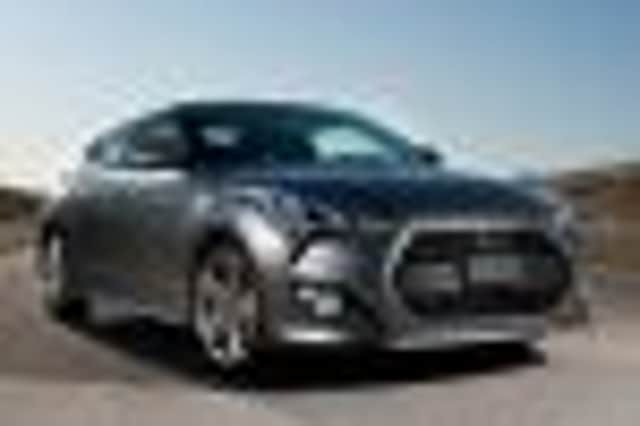Preview: Hyundai Veloster Turbo 2+1 adds up to attractive sum


It’s got wonky doors
You mean it’s blessed with a so-called “2+1” body style, aiming to offer the looks of a racy coupe with the practicality of a family hatchback. Meeting this rather challenging design brief meant doing things with doors. So you’ve a single long door on the driver’s side but a pair of shorter openings opposite, with a few deft styling tweaks to disguise the fact.
Only Mini’s Clubman has tried this in the past and then only half-heartedly with a driver’s-side rear door that dumped its occupants into the roadway. In contrast, Hyundai’s designers have done the job properly, creating separate body shells for left and right-hand drive markets so the extra doors will always be available to you at the kerbside. Sounds sensible, but the car that clothes them is resolutely sporting.
Handling the pressure
Advertisement
Hide AdAdvertisement
Hide AdRacy looks are one thing. Racy performance is another. If you want it here, you’ll need the 186PS turbo version, which can cut the 0-60mph time down to 8.4s and enjoy a lot more pulling power – 270Nm of torque rather than the 167Nm offered by the normally aspirated 1.6-litre model.
With the turbo variant, Hyundai has also addressed some previous niggles. So a quicker-ratio steering rack offers sharper response through corners, front and rear suspension tweaks allow greater dynamic composure and wider gear ratios mean less use is needed of the rather notchy six-speed manual gearbox.
It reminds me of, err, um, a...
This, we’re told, is “the next evolution of Hyundai’s design language”. They call it “Fluidic Sculpture” and if this really is the way it’s going, then future models are going to look very dramatic indeed.
Everywhere on this Veloster you’ll find signs of styling flourish – a grille here, a slash there, with lines, curves, cutaways and slopes busily converging into a surprisingly cohesive end result. From every angle this car seems different: I’ve certainly never tired of looking at it. While there are countless design cues that may remind you of other cars, the Veloster somehow still emerges with its own distinct look and feel, with a top glasshouse section that Hyundai claims is inspired by a motorcyclist’s crash helmet. From the rear, twin central exhausts, reflectors set into the wheel arches, rear combination lights curved to follow the bodywork and cutaways in the tailgate offer further distinctive touches. The turbo model is set apart by a larger spoiler, LED accents on the tail lamps, a unique set of bumpers and, moving further around, things like inbuilt foglights, a bolder grille and larger 18-inch alloy wheels.
Ultimately though, it is the doors that define this design. We’re talking pure sports coupe here on the driver’s side. As, at first glance, you might think is the case when you walk around to the opposite flank of the car. But a closer look reveals this “2+1” design’s cleverness. On this side, rather than one long driver’s door, you’ve two shorter doors separated by a central pillar, with the handle for the rear opening disguised in the window frame.
What price performance?
Once you’ve properly specified your Veloster turbo, you’re probably looking at around £25,000, depending on the spec combination you choose. Expect auto headlamps, reverse parking sensors, a seven-inch TFT colour touchscreen, a Bluetooth system with voice recognition, MP3-compatible stereo with wheel-mounted controls and climate control. Top models also get heated front seats, cruise control, keyless entry and a large panoramic glass sunroof that looks good but will rob taller drivers of a bit of headroom.This car achieved a five-star Euro NCAP safety testing result, ahead of rivals such as the VW Scirocco and the Vauxhall Astra GTC. There are six airbags, anti-whiplash head restraints, plus the expected electronic driving aids for traction, braking and stability control.
Is it easy to live with?
The Veloster’s excellent value for money is compounded by some very respectable cost-of-ownership figures. Day-to-day running costs are kept pretty well in check, with the manual model returning a combined fuel economy figure of 35-40mpg and a CO2 return of just over 150g/km. A gear change indicator on the dash should help owners get somewhere near these kinds of figures on an ordinary day-to-day basis.
That’s not the end of it. Excellent safety and security ratings and a modest cost of repair have seen the Veloster achieve an affordable insurance rating on a par with mainstream rivals. But none of these can get close to the aftersales care on offer from Hyundai. The brand’s “Five Year Triple Care” scheme means you’ll get an unlimited mileage warranty, five years of roadside assistance and an annual health check for your car from your dealer.
The thinking man’s coupe
Advertisement
Hide AdAdvertisement
Hide AdSome cars offer a very straightforward customer proposition. The Veloster isn’t one of them. You’ll see it being compared to sports coupes like the Volkswagen Scirocco or the Peugeot RCZ but it’s nothing like them. What it offers is a car for the person who maybe has a young family but isn’t ready for the vanilla image of a five-door family hatch just yet. Or for a coupe customer more interested in style and practicality than driving on the edge. Both types of buyers should like this Hyundai very much.